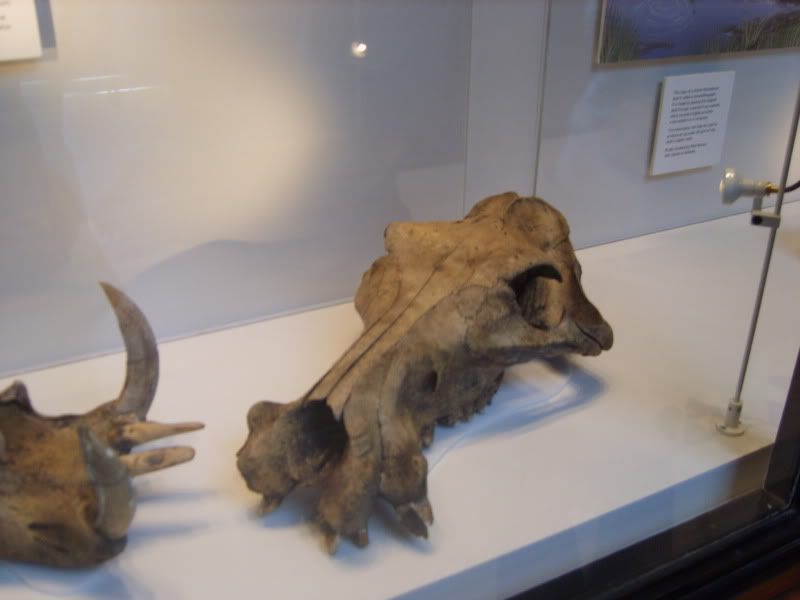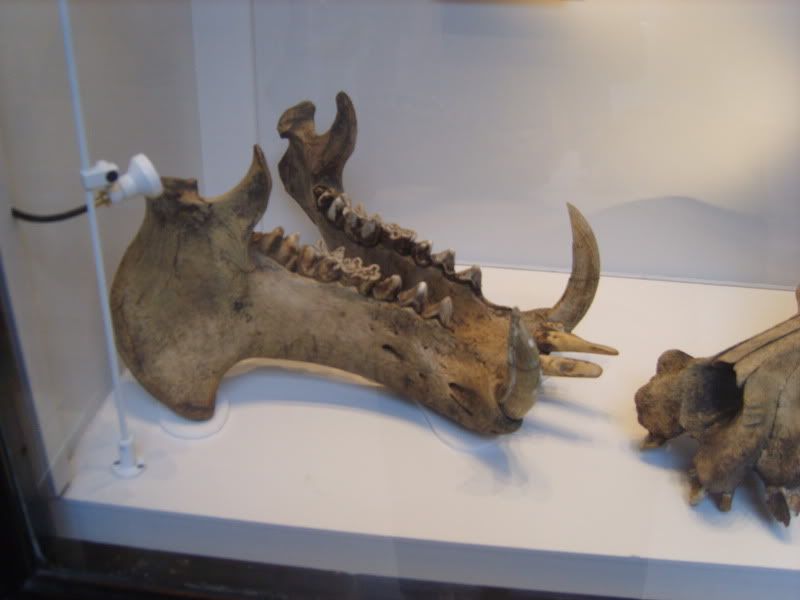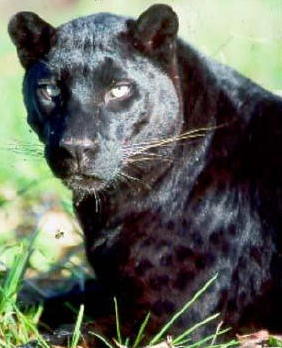|
|
Post by another specialist on Jun 26, 2009 8:32:00 GMT
Nigerian subspecies A distinct subspecies of pygmy hippopotamus lived in Nigeria until at least the 20th century. The existence of the subspecies, makes Choeropsis liberiensis liberiensis (or Hexaprotodon liberiensis liberiensis under the old classification) the full trinomial nomenclature for the Liberian pygmy hippopotamus. The Nigerian pygmy hippopotamus subspecies was never studied in the wild and never captured. All research and all zoo specimens are the Liberian subspecies. The Nigerian subspecies is classified as C. liberiensis heslopi.[7] The Nigerian pygmy hippopotamus ranged in the Niger River Delta, especially near Port Harcourt, but no reliable reports exist after the collection of the museum specimens secured by I. R. P. Heslop, a British colonial officer, in the early 1940s. It is believed to be extinct. The subspecies was separated by over 1,800 kilometres (1,100 mi) and the Dahomey Gap, a region of desert that divides the forest regions of West Africa. The subspecies is named after I. R. P. Heslop, who claimed in 1945 to have shot a pygmy hippo in the Niger Delta region and collected several skulls. He estimated that perhaps no more than 30 pygmy hippos remained in the region.[12] Heslop reportedly sent four pygmy hippopotamus skulls he collected to the British Museum of Natural History in London. These specimens were not subjected to taxonomic evaluation, however, until 1969 when G. B. Corbet classified the skulls as belonging to a separate subspecies based on consistent variations in the proportions of the skulls.[13] The Nigerian pygmy hippos were seen or shot in Rivers State, Imo State and Bayelsa State, Nigeria. While some local populations are aware that the species once existed, its history in the region is poorly documented.[7] en.wikipedia.org/wiki/Pygmy_Hippopotamus |
|
|
|
Post by Melanie on Jun 26, 2009 9:24:48 GMT
The second subspecies, H. l. heslopi, is known only from the Niger Delta east to the vicinity of the Cross River in Nigeria (Corbet 1969). This second, isolated population in Nigeria is some 1,800 km to the east of the known populations, on the other side of the Dahomey Gap. Such a discontinuous distribution is very rare amongst forest vertebrates in West Africa and Robinson (1970) considers that there is insufficient evidence to confirm that the species ever existed in Nigeria, despite the account by Heslop (1945), who shot one near Omoku in the vicinity of the Niger Delta. This putative Pygmy Hippo subspecies was identified in 1945 based on morphological features of skulls collected in the late 1930s in Nigeria. Others have been equally skeptical, but Ritchie (1930) gave measurements of two skulls that were obtained in 1928 from the Niger Delta so there seems little doubt that the species did once occur in the country. It may be extinct, but Oates (in litt. 1993) reported that residents in the Niger Delta still knew of the species. Although the 1993 Action Plan posits that H. l. heslopi individuals may still occur in the Niger Delta, the existence of this subspecies has not been confirmed or reported. There is little possibility that this Niger delta population still survives, although it is surprising that the existence was so poorly known or documented. www.iucnredlist.org/details/10032/0 |
|
|
|
Post by another specialist on Jun 27, 2009 19:10:59 GMT
My own photos from Natural History Museum of London - June 25   |
|
|
|
Post by surroundx on Dec 7, 2012 8:31:37 GMT
"Indeed, she herself had a long-term interest in ethnoscience and it was through the descriptions of Ịjọ hunters of the pygmy hippo that residual populations of this rare animal were first identified." (p. i) "Pygmy Hippo Hexaprotodon (Choeropsis) liberiensis
For lack of recent reports, the 1994 IUCN Red List ranked the Nigerian Pygmy Hippo (Hexaprotodon liberiensis heslopi) as Extinct (see also Eltringham, 1993b). There is indeed a consensus, based on hunters’ accounts, that the Pygmy Hippo did become extinct or practically so in the 1960’s in some areas: the NigerOrashi floodplain corridor, the Taylor Creek conservation area, and the Yenagoa and the Okoroba areas (Oates, 1989; Were, 1991; Powell, 1993; pers. comm., Ashton-Jones). A few reports, consistent with a lone vagrant specimen, have been received in the OdiSampou area in the early 1990’s. In two other areas, not visited by earlier workers, there are local reports that the Pygmy Hippos survives. These are southeast of Tungbo in the proposed Egbedi Creek Forest reserve, and more especially the Upper Orashi Forest Reserve. The reports mostly concern the sighting of tracks or evidence of disturbance to water and vegetation in ponds and lakes in the dry season when such waters are fished. None concerns mothers with young. Hunters and bush fishermen in the two areas take the species as rare and limited to the most remote areas. The historical distribution of the Pygmy Hippo appears limited to the ‘flood forest’ zone. It can be traced by local knowledge of its name, which persists among hunters due to the animal’s legendary spiritual powers and associated rituals required on killing a specimen (odufiowei, abein or ebei in Ijo-group languages; agumagu or ogomogu in Igbo-group languages). It appears the species’ western limit ran along the Niger-Forcados-Sagbama Rivers, and the eastern boundary was along the Orashi system. The southern limit ran from Bomadi or Sagbama south almost to Oporoma then southeast to the Ogbia area. Anadu and Oates (1982) could not obtain evidence for the animal’s existence at any of their interview sites.
The main treat to the species survival appears to be habitat destruction and general disturbance from logging and similar activities especially in the Upper Orashi Forest Reserve. Although a few living hunters are known to have killed specimens, the average local hunter is unlikely to do so. For instance one common superstition in the Upper Orashi reserve area is that anyone who kills an ebein will become mentally deranged, see his colleagues and other humans as bush-meat and start macheting them etc." (p. 34-35) Source: www.rogerblench.info/Ethnoscience/Animals/Mammals/Niger%20Delta%20mammal%20book.pdf--------------------------------------------------------------------------------------------------------------------------------- References:Anadu P.A. & Oates J.F., 1982. The status of wildlife in Bendel State, Nigeria, with Recommendations for its Conservation. A report prepared for submission to the Bendel State Ministry of Agriculture and Natural Resources, the Nigerian Federal Ministry of Agriculture, the Nigerian conservation Foundation, the New York zoological society and the World Wildlife Fund (US). December 1982. pp. iii + 41. (WWF/IUCN Project 1613.) Eltringham, S.K., 1993b. The Pygmy Hippopotamus (Hexaprotodon liberiensis). Section 3.3 pp 55-60 in: Oliver, Wm L R (ed.). Pigs Peccaries, and Hippos. Status survey and conservation action plan. IUCN/SSC Pigs & Peccaries Specialist Group; and IUCN/SSC Hippo Specialist Group. xiii + 202pp. IUCN, Gland, Switzerland. Oates, J.F., 1989. A survey of primates and other forest wildlife in Anambra, Imo and Rivers States, Nigeria. A report to the Nat-Foundation, the Nigerian Federal Dept of Forestry, and the Governments of Anambra, Imo and Rivers States. Pp ii+40. mimeo. Powell, C. B. 1993. Sites and species of conservation interesting the central axis of the Niger Delta (Yenegoa, Sagbama, Ekeremor and Southern Ijo Local Government Areas). A report of recommendations to the Natural Resources Conservation Council (NARESCON), Abuja. Werre, Lodewijk 1991. A survey of the Taylor Creek Forest Area, Rivers State, Nigeria. Ph.D. Program in Anthropology, City University of New York. 21 pp + 3 maps, mimeo. November 1991.
|
|
|
|
Post by Bhagatí on Dec 8, 2012 22:21:07 GMT
The only source I know too well. And I threw it here and much more, if it was credible. Well, clearly, so definitely not! I am deeply disappointed that source, , as mixing apples with pears, and honestly and truthfully not responding according to criteria such as would be correct! And it was that very clearly reflected in the illustrations, that the pictures of this source. Picture of flat-headed mongoose is yellow mongoose. And it is not, far from everything. On the one hand, although the text is very professional; on the other hand for example, in pygmy hippos the pictures of the animals from a totally different area. And it's not Nigerian Pygmy hippos, but more west african pygmy hippo subspecies. And let meclaim that they do not even took pictures of nature, but from captivity. What is the source for this, and certainly, a very reprehensible act. A similar such upsets very thick, is filled with all this PDF file. For example, instead bushbuck there is commonest nyala. Or instead Olive Colobus is commonest east african - mantled guereza. Or Needle-clawed Galago replaced by common, senegal galago. And so on. And neither is it a very even really trying. What is with this source, obvious, and certainly the rule. Such a very large number of upsets, which certainly reduces thevery professional level of the text with which you and certainly, put a lot of effort. Such a shame, because a just through the entire PDF file as losing efficiency. If you already. Keep it surroundx, Congratulations.  P.S.: And personally, I think they did a very sloppy. Besides the information from the PDF file, they are already past. So much less and therefore are not up to date. Well, all is not gold that glitters!  |
|
|
|
Post by Peter on Apr 28, 2013 19:50:09 GMT
Source: Mallon, D., Wightman, C., De Ornellas, P., Collen, B. and Ransom, C.(Compilers) 2011. Conservation Strategy for the Pygmy Hippopotamus. IUCN Species Survival Commission. Gland, Switzerland and Cambridge, UK. ( cmsdata.iucn.org/downloads/pygmyhippoconservationstrategy_iucnssc_final_en.pdf)
|
|
|
|
Post by koeiyabe on Dec 5, 2015 1:59:16 GMT
"Lost Animals (in Japanese)" by WWF Japan (1996)  |
|
|
|
Post by Sebbe on May 12, 2017 20:19:55 GMT
|
|
|
|
Post by Melanie on Jul 26, 2017 1:06:31 GMT
Corbet's original description
G. B. Corbet: The taxonomic status of the Pygmy hippopotamus, Choeropsis liberiensis, from the Niger Delta Journal of Zoology, Volume 158, Issue 3, July 1969, p 387–394
|
|
|
|
Post by surroundx on Jul 29, 2017 14:47:44 GMT
|
|










